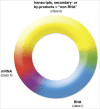What is an RNA? A top layer for RNA classification
- PMID: 26818079
- PMCID: PMC4829331
- DOI: 10.1080/15476286.2015.1128064
What is an RNA? A top layer for RNA classification
Abstract
Every ribonucleic acid begins its cellular life as a transcript. If the transcript or its processing product has a function it should be regarded an RNA. Nonfunctional transcripts, by-products from processing, degradation intermediates, even those originating from (functional) RNAs, and non-functional products of transcriptional gene regulation accomplished via the act of transcription, as well as stochastic (co)transcripts could simply be addressed as transcripts (class 0). The copious functional RNAs (class I), often maturing after one or more processing steps, already are systematized into ever expanding sub-classifications ranging from micro RNAs to rRNAs. Established sub-classifications addressing a wide functional diversity remain unaffected. mRNAs (class II) are distinct from any other RNA by virtue of their potential to be translated into (poly)peptide(s) on ribosomes. We are not proposing a novel RNA classification, but wish to add a basic concept with existing terminology (transcript, RNA, and mRNA) that should serve as an additional framework for carefully delineating RNA function from an avalanche of RNA sequencing data. At the same time, this top level hierarchical model should illuminate important principles of RNA evolution and biology thus heightening our awareness that in biology boundaries and categorizations are typically fuzzy.
Keywords: Background transcription; functional RNA; fuzzy boundaries; mRNA; spurious transcripts; three superclasses.
Figures

Similar articles
-
Does every transcript originate from a gene?Ann N Y Acad Sci. 2015 Apr;1341:136-48. doi: 10.1111/nyas.12741. Ann N Y Acad Sci. 2015. PMID: 25847549
-
Quality control systems for aberrant mRNAs induced by aberrant translation elongation and termination.Biochim Biophys Acta. 2013 Jun-Jul;1829(6-7):634-42. doi: 10.1016/j.bbagrm.2013.02.004. Epub 2013 Feb 14. Biochim Biophys Acta. 2013. PMID: 23416749 Review.
-
Waste not, want not--transcript excess in multicellular eukaryotes.Trends Genet. 2005 May;21(5):287-8. doi: 10.1016/j.tig.2005.02.014. Trends Genet. 2005. PMID: 15851065 Review.
-
Identification and expression analysis of putative mRNA-like non-coding RNA in Drosophila.Genes Cells. 2005 Dec;10(12):1163-73. doi: 10.1111/j.1365-2443.2005.00910.x. Genes Cells. 2005. PMID: 16324153
-
Noncoding RNA transcripts.J Appl Genet. 2003;44(1):1-19. J Appl Genet. 2003. PMID: 12590177 Review.
Cited by
-
Brain Long Noncoding RNAs: Multitask Regulators of Neuronal Differentiation and Function.Molecules. 2021 Jun 28;26(13):3951. doi: 10.3390/molecules26133951. Molecules. 2021. PMID: 34203457 Free PMC article. Review.
-
Sequence based model using deep neural network and hybrid features for identification of 5-hydroxymethylcytosine modification.Sci Rep. 2024 Apr 20;14(1):9116. doi: 10.1038/s41598-024-59777-y. Sci Rep. 2024. PMID: 38643305 Free PMC article.
-
The uprise of RNA biology in neuroendocrine neoplasms: altered splicing and RNA species unveil translational opportunities.Rev Endocr Metab Disord. 2023 Apr;24(2):267-282. doi: 10.1007/s11154-022-09771-4. Epub 2022 Nov 24. Rev Endocr Metab Disord. 2023. PMID: 36418657 Free PMC article. Review.
-
Identification of circular RNA expression profiles in renal fibrosis induced by obstructive injury.Ren Fail. 2021 Dec;43(1):1368-1377. doi: 10.1080/0886022X.2021.1979040. Ren Fail. 2021. PMID: 34602010 Free PMC article.
-
Principles and correction of 5'-splice site selection.RNA Biol. 2022 Jan;19(1):943-960. doi: 10.1080/15476286.2022.2100971. RNA Biol. 2022. PMID: 35866748 Free PMC article. Review.
References
-
- St Laurent G, Wahlestedt C, Kapranov P. The Landscape of long noncoding RNA classification. Trends Genet 2015; 31:239-51; PMID:25869999; http://dx.doi.org/10.1016/j.tig.2015.03.007. - DOI - PMC - PubMed
-
- Cech TR, Steitz JA. The noncoding RNA revolution-trashing old rules to forge new ones. Cell 2014; 157:77-94; PMID:24679528; http://dx.doi.org/10.1016/j.cell.2014.03.008. - DOI - PubMed
-
- Vickers KC, Roteta LA, Hucheson-Dilks H, Han L, Guo Y. Mining diverse small RNA species in the deep transcriptome. Trends Biochem Sci 2015; 40:4-7; PMID:25435401; http://dx.doi.org/10.1016/j.tibs.2014.10.009. - DOI - PMC - PubMed
-
- Levene PA. The structure of yeast nucleic acid. IV Ammonia hydrolysis. J Biol Chem 1919; 40:415-24.
-
- Brachet J. La localisation des acides pentose-nucléiques dans les tissue animaux et les oeufs d'amphibiens en voie de développment. Arch Biol (Liege) 1941; 53:207-57.
MeSH terms
Substances
LinkOut - more resources
Full Text Sources
Other Literature Sources
